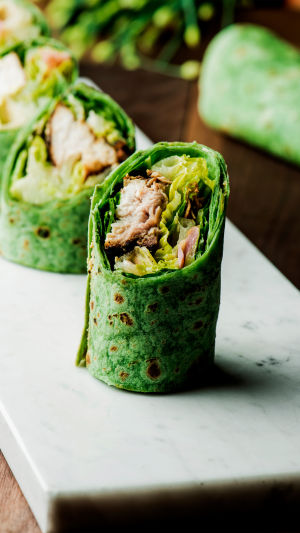Chicken wraps, cherished worldwide for their exquisite taste and diverse preparation techniques, have captured the hearts of food enthusiasts across the globe.
Whether served as part of a wholesome meal or enjoyed as a snack or appetizer, chicken wraps exude their own distinctive allure.
1. Historical Origins
The origins of chicken wraps can be traced back to ancient times, with various countries and cultures boasting similar culinary creations.
However, as time progressed, chicken wraps underwent a metamorphosis, evolving into a versatile and creatively enticing cuisine. Chefs around the world were drawn to experimenting with novel ingredients and innovative cooking approaches.
2. Preparation Techniques
Ingredient Preparation: The core ingredient is chicken, allowing for the choice between succulent chicken breast or flavorful chicken leg cuts, customized to individual preferences.
Additionally, a variety of toppings, such as vegetables, cheese, and mushrooms, can be handpicked to tantalize the taste buds.
Marination: Chicken can be marinated beforehand, absorbing a blend of seasonings including salt, pepper, soy sauce, and olive oil. This infusion of flavors enhances the overall taste.
Slicing Chicken: The marinated chicken is expertly carved into thin slices and gently flattened using a rolling pin to ensure uniform thickness.
Assembling the Wraps: Laying out the chicken slices, an assortment of toppings is meticulously arranged on top. Personal preferences dictate the addition of vegetable strips, cheese sticks, and more.
Rolling the Wrap: Commencing from one end, the chicken slices are deftly rolled, encapsulating the toppings within to form a compact roll.
Cooking Process: The rolled chicken is then placed in a preheated pan, where it is meticulously pan-fried over medium-low heat until achieving a succulent, golden-brown exterior.
3. Variety of Popular Versions
The fusion of diverse cultures has birthed a plethora of chicken wrap variations across the globe, epitomizing culinary innovation and diversity. Here are some notable renditions:
Chicken Burrito: Generous portions of chicken, boiled rice, beans, and vegetables are nestled within a large corn or wheat tortilla. Topped with cheese and accompanied by sour cream and hot sauce, this Mexican creation is a burst of flavors.
Asian Spring Roll (Chicken Spring Roll): Thinly sliced chicken and shredded vegetables are enveloped within a delicate pancake, deep-fried to a tantalizing golden crispness—a beloved Asian delicacy.
Chicken Roulade: Chicken is meticulously rolled into a circular formation, brimming with a medley of fillings, including cheese, and vegetables, before being oven-baked to perfection.
4. Nutritional Value
Beyond their delectable taste, chicken wraps boast significant nutritional merits. Chicken serves as a prime source of high-quality protein, enriched with essential vitamins such as B6, B12, niacin, and vital minerals including phosphorus and selenium.
The incorporation of vegetables provides an abundant supply of fiber, vitamins, and minerals. It is worth noting that cooking methods and topping choices influence the overall nutritional profile; deep-frying introduces calories, while excessive cheese and sauces may elevate fat and sodium content.
Chicken wraps, as a fusion of creativity, flavor, and nutrition, have transcended conventional techniques, adapting to the influences of diverse cultures. Whether enjoyed during family gatherings, restaurant dining experiences, or as street food, chicken wraps undeniably present an irresistible temptation.
Whether your preference leans toward the zest of Mexican burritos or the charm of Asian spring rolls, each indulgent bite unveils a cultural journey. May this article provide a comprehensive understanding of chicken wraps and kindle an appetite for the myriad flavors that grace your future tables.





